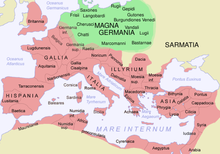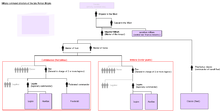



The Valentinian dynasty was a ruling house of five generations of dynasts, including five Roman emperors during late antiquity, lasting nearly a hundred years from the mid fourth to the mid fifth century. They succeeded the Constantinian dynasty (r. 306–363) and reigned over the Roman Empire from 364 to 392 and from 425 to 455, with an interregnum (392–423), during which the Theodosian dynasty ruled and eventually succeeded them. The Theodosians, who intermarried into the Valentinian house, ruled concurrently in the east after 379.
The Valentinian dynasty's patriarch was Gratianus Funarius, whose sons Valentinian I and Valens were both made Roman emperors in 364. Valentinian I's two sons, Gratian and Valentinian II both became emperors. Valentinian I's daughter Galla married Theodosius the Great, the emperor of the eastern empire, who with his descendants formed the Theodosian dynasty (r. 379–457). In turn, their daughter, Galla Placidia married a later emperor, Constantius III (r. 421–421). Their son, Valentinian III (r. 425–455), who ruled in the west, was the last emperor of the dynasty, whose death marked the end of dynasties in the western empire. During the interregnum, Theodosius' son Honorius ruled in the west, and concurrently with Galla Placidia from 421. The dynasty has been labelled as Pannonian, based on the family origin in Pannonia Secunda in the western Balkans.
Under the Valentinians, dynastic rule was consolidated and the division of the empire into west and east became increasingly entrenched. The empire was subject to repeated incursions along its borders, with the Danube frontier eventually collapsing in the northeast and barbarian invasions in the west eventually reaching Italy, and culminating with the sack of Rome in 410, which foreshadowed the eventual dissolution of the western empire in the late fifth century.
Cite error: There are <ref group=lower-alpha> tags or {{efn}} templates on this page, but the references will not show without a {{reflist|group=lower-alpha}} template or {{notelist}} template (see the help page).
![Solidus of Valens[a] of Valentinianic](http://upload.wikimedia.org/wikipedia/commons/thumb/b/b0/INC-1867-r_%D0%A1%D0%BE%D0%BB%D0%B8%D0%B4._%D0%92%D0%B0%D0%BB%D0%B5%D0%BD%D1%82_II._%D0%9E%D0%BA._375%E2%80%94378_%D0%B3%D0%B3._%28%D1%80%D0%B5%D0%B2%D0%B5%D1%80%D1%81%29.png/170px-INC-1867-r_%D0%A1%D0%BE%D0%BB%D0%B8%D0%B4._%D0%92%D0%B0%D0%BB%D0%B5%D0%BD%D1%82_II._%D0%9E%D0%BA._375%E2%80%94378_%D0%B3%D0%B3._%28%D1%80%D0%B5%D0%B2%D0%B5%D1%80%D1%81%29.png)
